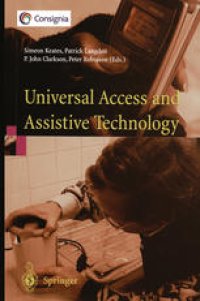
Ebook: Universal Access and Assistive Technology: Proceedings of the Cambridge Workshop on UA and AT ’02
- Tags: Biomedical Engineering, Engineering Design, User Interfaces and Human Computer Interaction, Control Robotics Mechatronics, Image Processing and Computer Vision, Rehabilitation
- Year: 2002
- Publisher: Springer-Verlag London
- Edition: 1
- Language: English
- pdf
The first Cambridge Workshop on Universal Access and Assistive Technology (CWUAAT) was held at Trinity Hall, Cambridge, in March 2002. It was inspired by the earlier, highly successful Cambridge Workshops on Rehabilitation Robotics organised by the late Robin Jackson. Robin was the founder of Rehabilitation Research at Cambridge which now continues in the Engineering Design Centre within the Department of Engineering, led by John Clarkson and Simeon Keates, and in the Rainbow Group within the Computer Laboratory led by Peter Robinson. CWUAAT represents the first in a new series of workshops that we are aiming to hold every two years which, reflecting the spirit of recent moves to extend the rights for universal accessibility, will encourage discussion of a broad range of interests. There will be a general focus on product/solution development. Hence it is intended that the principal requirements for the successful design of assistive technology shall be addressed, where these range from the identification and capture of the needs of the users, through to the development and evaluation of truly usable and accessible systems for users with special needs. The best submissions received for the first CWUAAT are contained in this book, where the contributors are all leading researchers in the fields of Universal Access and Assistive Technology and represent a large part of the international research community. They include, though not exclusively, computer scientists, designers, engineers, industrial representatives, ergonomists and sociologists.
Content:
Front Matter....Pages i-xiv
Front Matter....Pages 1-1
Commercial Perspectives on Universal Access and Assistive Technology....Pages 3-10
Front Matter....Pages 11-11
Defining Design Exclusion....Pages 13-22
Quantifying Design Exclusion....Pages 23-32
Countering Design Exclusion....Pages 33-42
Inclusive Design — Developing Theory Through Practice....Pages 43-52
A Systematic Basis for Developing Cognitive Assessment Methods for Assistive Technology....Pages 53-62
Control of Virtual Environments for People with Intellectual Disabilities....Pages 63-72
Front Matter....Pages 73-73
Why Are Eye Mice Unpopular? — A Detailed Comparison of Head and Eye Controlled Assistive Technology Pointing Devices....Pages 75-86
Cursor Characterisation and Haptic Interfaces for Motion-impaired Users....Pages 87-96
Web-based Multimodal Graphs for Visually Impaired People....Pages 97-108
Automatically Rearranging Structured Data for Customised Special-Needs Presentations....Pages 109-118
Bridging the Education Divide....Pages 119-130
Contextual On-line Help: A Contribution to the Implementation of Universal Access....Pages 131-140
3rd Age Interfaces: A Usability Evaluation of the ‘Your Guide’ Kiosk Prototype from an Older User’s Perspective....Pages 141-150
Virtual Environments for the Training of the Visually Impaired....Pages 151-160
User Involvement in the Design of a New Multimedia Communication Service....Pages 161-170
Issues Surrounding the User-centred Development of a New Interactive Memory Aid....Pages 171-178
Games Children with Autism Can Play with Robota, a Humanoid Robotic Doll....Pages 179-190
Front Matter....Pages 191-191
Progress of a Modular Prosthetic Arm....Pages 193-200
Development of a Novel Type Rehabilitation Robotic System KARES II....Pages 201-212
Front Matter....Pages 191-191
Improving the Flexibility of an Assistive Robot....Pages 213-222
Commercialising Assistive and Therapy Robotics....Pages 223-234
Improved Assistive Technology Prescription via Usage Log Analysis....Pages 235-244
Virtual Interface Development and Sensor-based Door Navigation for Nonholonomic Vehicles....Pages 245-256
An Ergonomic One-handed Wheelchair....Pages 257-266
Gathering User Needs in the Development of the POWER-HAND Opening Aid — A Successful Consumer Product for the Wider Market....Pages 267-276
Locomotion Assistance for the Blind....Pages 277-284
‘Keep Taking the Medication’: Assistive Technology for Medication Regimes in Care Settings....Pages 285-294
“I can’t talk now,” and Other Design Stories: Four Assistive Technologies for People With and Without Disabilities....Pages 295-304
Back Matter....Pages 305-306
Content:
Front Matter....Pages i-xiv
Front Matter....Pages 1-1
Commercial Perspectives on Universal Access and Assistive Technology....Pages 3-10
Front Matter....Pages 11-11
Defining Design Exclusion....Pages 13-22
Quantifying Design Exclusion....Pages 23-32
Countering Design Exclusion....Pages 33-42
Inclusive Design — Developing Theory Through Practice....Pages 43-52
A Systematic Basis for Developing Cognitive Assessment Methods for Assistive Technology....Pages 53-62
Control of Virtual Environments for People with Intellectual Disabilities....Pages 63-72
Front Matter....Pages 73-73
Why Are Eye Mice Unpopular? — A Detailed Comparison of Head and Eye Controlled Assistive Technology Pointing Devices....Pages 75-86
Cursor Characterisation and Haptic Interfaces for Motion-impaired Users....Pages 87-96
Web-based Multimodal Graphs for Visually Impaired People....Pages 97-108
Automatically Rearranging Structured Data for Customised Special-Needs Presentations....Pages 109-118
Bridging the Education Divide....Pages 119-130
Contextual On-line Help: A Contribution to the Implementation of Universal Access....Pages 131-140
3rd Age Interfaces: A Usability Evaluation of the ‘Your Guide’ Kiosk Prototype from an Older User’s Perspective....Pages 141-150
Virtual Environments for the Training of the Visually Impaired....Pages 151-160
User Involvement in the Design of a New Multimedia Communication Service....Pages 161-170
Issues Surrounding the User-centred Development of a New Interactive Memory Aid....Pages 171-178
Games Children with Autism Can Play with Robota, a Humanoid Robotic Doll....Pages 179-190
Front Matter....Pages 191-191
Progress of a Modular Prosthetic Arm....Pages 193-200
Development of a Novel Type Rehabilitation Robotic System KARES II....Pages 201-212
Front Matter....Pages 191-191
Improving the Flexibility of an Assistive Robot....Pages 213-222
Commercialising Assistive and Therapy Robotics....Pages 223-234
Improved Assistive Technology Prescription via Usage Log Analysis....Pages 235-244
Virtual Interface Development and Sensor-based Door Navigation for Nonholonomic Vehicles....Pages 245-256
An Ergonomic One-handed Wheelchair....Pages 257-266
Gathering User Needs in the Development of the POWER-HAND Opening Aid — A Successful Consumer Product for the Wider Market....Pages 267-276
Locomotion Assistance for the Blind....Pages 277-284
‘Keep Taking the Medication’: Assistive Technology for Medication Regimes in Care Settings....Pages 285-294
“I can’t talk now,” and Other Design Stories: Four Assistive Technologies for People With and Without Disabilities....Pages 295-304
Back Matter....Pages 305-306
....